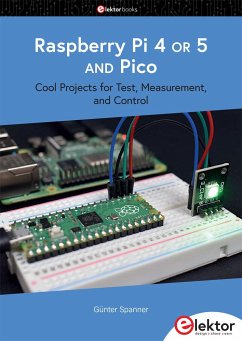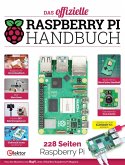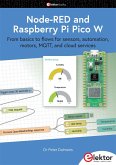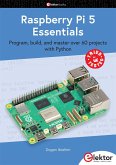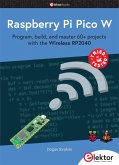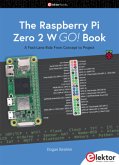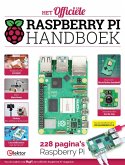The Raspberry Pi has dominated the maker scene for many years. Freely accessible I/O pins have made it one of the most popular processor boards of all time. However, the classic Raspberry Pi has no analog inputs. Direct measurement of analog values is therefore not possible. Consequently, photodiodes, NTCs, Hall sensors, etc. cannot be read directly. In addition, the pins are connected directly to the exposed contacts, i.e. without a driver or protection circuit. This can quickly destroy the central controller and thus the entire Raspberry Pi.
These problems can be elegantly solved with the Pico. As a front-end, it can easily handle a wide range of measurement tasks. In addition, the Pico is much cheaper than a classic Raspberry Pi 4 or 5. If a faulty circuit leads to the destruction of the Pico, this is relatively easy to handle. This makes the combination of a classic Raspberry Pi 4 or 5 and the Pico an ideal pair.
The book introduces the broad and highly topical field of modern controller technology using the combined force of a Raspberry Pi 4 or 5 and a Raspberry Pi Pico. In addition to a detailed introduction to the operation and functionality of the controller boards themselves, the book also focuses on data acquisition and processing with digital processors. Especially the combination of both systems offers a wide range of interesting possibilities.
Some practical projects from the contents:
USB between Raspberry Pi 4 or 5 and PicoI²C Communication and Pico as an I²C deviceVoltmeter and Computer ThermometerPico W as a Web Server and WLAN ScannerFrequency Meters and GeneratorsOLED Displays on Raspberry Pi 4 or 5 and PicoEnergy Saving MonitorWhich Astronauts are in Orbit?Mini Monitor for Current Bitcoin Exchange Rate
The programs from this book can be downloaded free of charge from the Elektor website www.elektor.com/20828.
These problems can be elegantly solved with the Pico. As a front-end, it can easily handle a wide range of measurement tasks. In addition, the Pico is much cheaper than a classic Raspberry Pi 4 or 5. If a faulty circuit leads to the destruction of the Pico, this is relatively easy to handle. This makes the combination of a classic Raspberry Pi 4 or 5 and the Pico an ideal pair.
The book introduces the broad and highly topical field of modern controller technology using the combined force of a Raspberry Pi 4 or 5 and a Raspberry Pi Pico. In addition to a detailed introduction to the operation and functionality of the controller boards themselves, the book also focuses on data acquisition and processing with digital processors. Especially the combination of both systems offers a wide range of interesting possibilities.
Some practical projects from the contents:
USB between Raspberry Pi 4 or 5 and PicoI²C Communication and Pico as an I²C deviceVoltmeter and Computer ThermometerPico W as a Web Server and WLAN ScannerFrequency Meters and GeneratorsOLED Displays on Raspberry Pi 4 or 5 and PicoEnergy Saving MonitorWhich Astronauts are in Orbit?Mini Monitor for Current Bitcoin Exchange Rate
The programs from this book can be downloaded free of charge from the Elektor website www.elektor.com/20828.

